Editorials
Stuffed with Fear: How Taxidermy Haunts the Horror Genre

I have unintentionally surrounded myself with stuffed animals for most of my life. Not those ones, though. The ones seen in the antique shops I visit, and the museums I work at, sometimes covered by protective glass or left to gather dust. Some of them are beautiful, some hilariously horrifying.
My Grandfather’s Craft: Beauty in the Macabre
Bill Waldron, my grandfather, was a skilled taxidermist. I remember Christmases visiting my grandparents in Minnesota, sleeping in their dark, musty spare room in the basement. Adjacent was my grandpa’s workroom: a windowless, incredibly bright cave potent with chemical fumes from myriad acids, glues, and paints. He was self-taught, and his work was beautiful.
After hunting or fishing trips, he often gave my dad taxidermy pieces of the animals they caught together: bear, deer, walleye, and even caribou. This caribou hung in our family living room, a cobwebbed fixture high above the fireplace. It fell one year and would have killed our dog had he been sleeping in his usual spot.
A dead animal is a really weird thing to put on your wall. Americans have been doing this for centuries. Taxidermy was all the rage in the Victorian era: it was a sign of wealth, masculinity, and virility. A trophy won, stuffed, and displayed for guests to see in your entryway, man cave, or den. Teddy Roosevelt’s Sagamore Hill residence on Long Island is a perfect example of how we use the American wilderness as art and furniture. Bucks, bears; swordfish, Great White sharks; pheasants, wolves; and yes, even beavers have something to offer aesthetically.
The Role of Taxidermy in Horror Movies
While the taxidermy animal may have been a specimen of craftsmanship and a symbol of American masculinity, in a post-Psycho (1960) America, the image of the taxidermist became ominous. They were recluses with a weird hobby, one that, more often than not, insinuated murderous impulses. After all, several real serial killers slaughtered small animals in their youth and took up taxidermy as a hobby (or cover-up). Ed Gein and Jefferey Dahmer, the former being the inspiration for Norman Bates, are notable examples.
The products of the taxidermist’s work adorn haunted, cracked walls; hide secrets; torment the living; and serve as portentous reminders of life’s absurdity. These mounted, macabre monstrosities can be incredibly campy, too. In some cases, perhaps the chemical fumes got to the artist’s head. The horror genre has embraced taxidermy and the allure of the skillful yet dangerous taxidermist.
The following list of characters is neither a ranking nor an analysis of their use of taxidermy on human victims. Wings and/or four-plus legs are prerequisites, folks!

Jame & Bubba
While chainsaw-wielding Leatherface (TCM, 1974) and the deranged Buffalo Bill do not explicitly perform animal taxidermy in their respective films, it’s hard to imagine them not experimenting with animals before, well…
Gumb, due to his perceived gender dysphoria, is drawn to the beautiful world of bugs. His favorite, the Death’s Head hawkmoth, became a creature synonymous with the horror genre. The Asiatic moth, raised from eggs, nourished by honey and nightshade, was “loved” by Gumb. “The significance of the moth is change,” states Dr. Hannibal Lecter, “Our Billy wants to change too.”
Taxidermy exposes the delicate beauty of moths and butterflies, focusing on the vibrant wings. Gumb’s walls were covered with odds and ends, a mixture of fascist imagery and delicate butterfly paintings. I wouldn’t be surprised if a framed butterfly or moth taxidermy display was framed somewhere in that house of tortures.
Similarly, Bubba Sawyer, known as Leatherface, enjoys toying with physical change in his respective house of horror. But, his apparent taxidermy, littering the walls of the Sawyer home, has nothing to do with his desire to transform.
Bubba’s taxidermy is focused on what’s around him in the Texas heat: longhorns, deer, armadillos. While the monarch butterfly is native to Texas, I think that would have been too delicate a taxidermy for a Sawyer to attempt.

Joe, “I’m getting into taxidermy.” “Of course you are. Classic!”
Joe is a lesser-known horror slasher. He is new to the craft, but boy is he busy! You’re Killing Me (2015) is a coming-out-as-a-murderer story, with Joe fresh out of a psychiatric institution and ready to start dating… among other things. The small animals he targets are mainly chickens and canaries, though it looks like he also dabbled with reptiles.
We learn that Joe comes from a stifling home life with a domineering mother, like Norman Bates, who had him committed to the hospital to curb his impulses. Speaking of Norman…
Norman, “My hobby is stuffing things.”
For not knowing much about birds, Norman seems to specialize in them. All kinds of birds! He is the quintessential taxidermist of horror, surrounding himself with his craft. “I hate the look of beasts when they’re stuffed,” Norman reasons, why he chooses birds for taxidermy. Scholar Subarna Mondal argues that Psycho “brought taxidermy in mainstream narrative cinema at a time when taxidermy was beginning to be reviled.
Concern for animal rights, wildlife preservation laws and a clear shift in cultural response to taxidermy had already begun to see the art as the grotesque mind’s propensity to create grotesque bodies.” (Mondal, 2017). Norman’s birds are symbols of his caged madness rather than mere stuffed animals.
Norman’s birds of prey are impressive, and beautiful in their likeness, despite Norman’s assertion he knows “nothing” about them. His work is merely a “hobby… to pass the time, not fill it.” I argue horror’s most passionate taxidermist comes in the form of an Oreo-loving, vampire-killing, pot-smoking grandpa who may or may not be a member of the undead.

Grandpa, “Talk about a Texas Chainsaw Massacre!”
Grandpa Emerson of The Lost Boys (1987) is an endearing figure. We first meet him playing dead to scare his family, which is the perfect segue into his home décor. His man cave’s aesthetic is Teddy Roosevelt meets the American Southwest… on a budget. It’s “a real “Texas Chainsaw Massacre,” as put by his grandson, Michael. Grandpa’s taxidermy is neither threatening, as with Leatherface’s body of work, nor precise, like Norman’s. This is evidenced by the odd critters he decides to preserve and gift his family (and dates!).
Maybe all the stuffed animals in Grandpa’s house are decoys for Santa Clara’s vampires, to throw them off the living humans inside. After all, he saves his whole family from the vamps. When I think of horror taxidermists, Grandpa always comes before Norman Bates. I prefer my taxidermists to be heroes.
My grandpa won competitions and awards with his taxidermy. In a feature for Minnesota’s Detroit Lakes Tribune, he was cited as a mentor for a local man getting into the craft, particularly woodcarving and painting fish. “He (Waldron) said, ‘I don’t want to offend you, but you could use some help with your painting.’” (Bowe, 2010).
Being a lineman for most of his adult life, the profession took a toll on his body. He became addicted to opioids in his 70s, resulting in a downslide physically and mentally. He passed away in 2024.
I still have the sunny he preserved for me; one we caught together on the lake. Funny, he always reminded me of Quint from Jaws, with his torn hat, mustache, and rough hands. Quint just didn’t have the artistry in him, I suppose: “Back home, I have a taxidermy man! He’s gonna have a heart attack when he sees what I brought him!”
Editorials
Is ‘Scream 2’ Still the Worst of the Series?
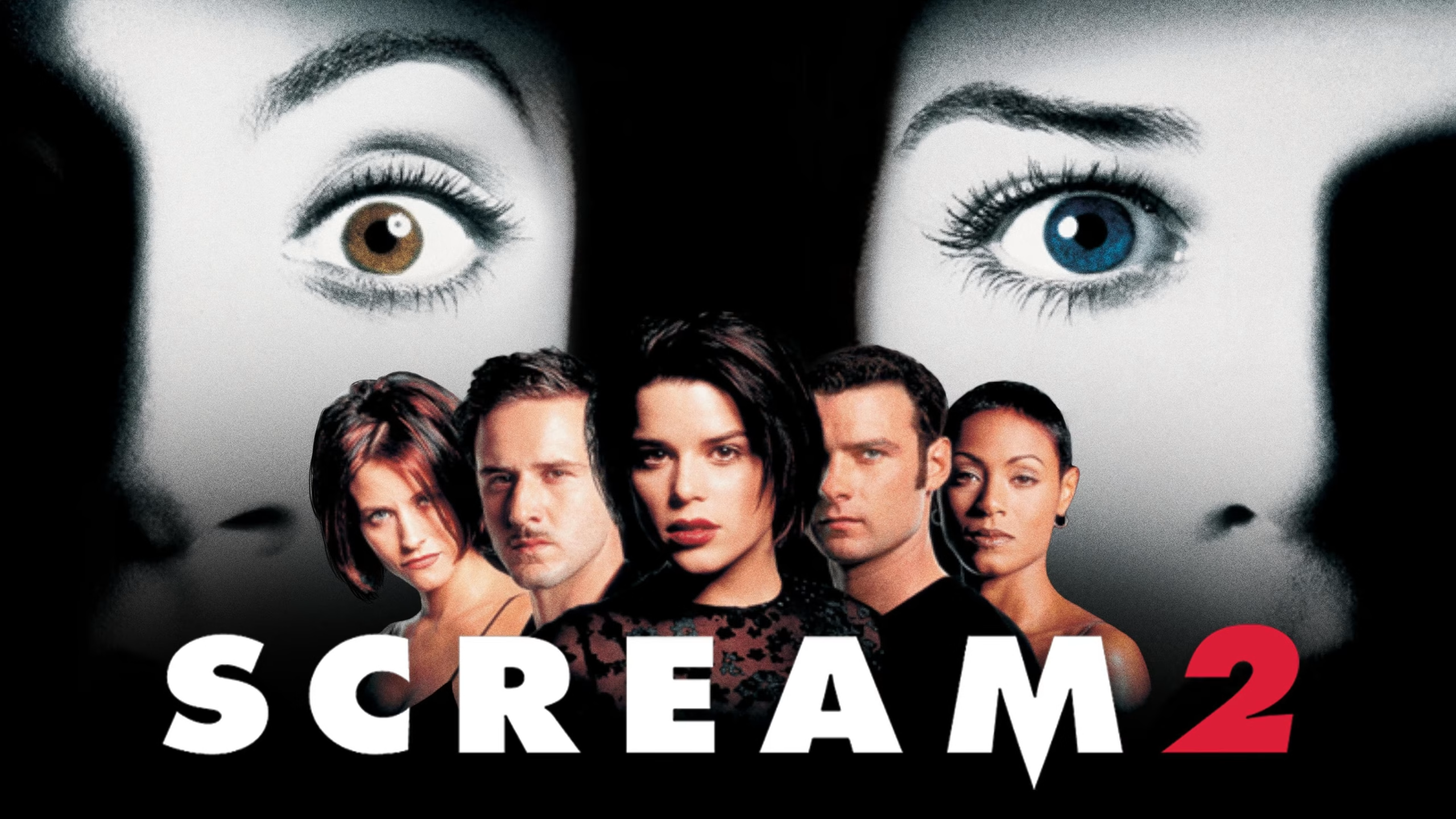
There are only so many times I can get away with burying the lede with an editorial headline before someone throws a rock at me. It may or may not be justified when they do. This article is not an attempt at ragebaiting Scream fans, I promise. Neither was my Scream 3 article, which I’m still completely right about.
I do firmly believe that Scream 2 is, at the very least, the last Scream film I’d want to watch. But what was initially just me complaining about a film that I disregard as the weakest entry in its series has since developed into trying to address what it does right. You’ve heard of the expression “jack of all trades, master of none”, and to me Scream 2 really was the jack of all trades of the franchise for the longest time.
It technically has everything a Scream movie needs. Its opening is great, but it’s not the best of them by a long shot. Its killers are unexpected, but not particularly interesting, feeling flat and one-dimensional compared to the others. It has kills, but only a few of them are particularly shocking or well executed. It pokes fun at the genre but doesn’t say anything particularly bold in terms of commentary. Having everything a Scream movie needs is the bare minimum to me.
But the question is, what does Scream 2 do best exactly? Finding that answer involves highlighting what each of the other sequels are great at, and trying to pick out what Scream 2 has that the others don’t.

Scream 3 Is the Big Finale That Utilizes Its Setting Perfectly
Scream as a series handily dodges the trap most horror franchises fall into: rehashing and retreading the same territory over and over. That’s because every one of its films are in essence trying to do something a little different and a little bolder.
Scream 3 is especially bold because it was conceived, written, and executed as the final installment in the Scream series. And it does that incredibly well. Taking the action away from a locale similar to Woodsboro, Scream 3 tosses our characters into the frying pan of a Hollywood film production. Despite its notorious number of rewrites and script changes (one of which resulted in our first solo Ghostface), it still manages to be a perfect culmination of Sidney Prescott’s story.
I won’t repeat myself too much (go read my previous article on the subject), but 3 is often maligned for as good a film as it turned out to be. And for all of its clunkier reveals, and its ghost mom antics, it understands how to utilize its setting and send its characters off into the sunset right.
Scream 4’s Meta Commentary Wakes Scream from a Deep Sleep
As Wes Craven’s final film, Scream 4 has a very special place in the franchise. It was and still is largely adored for bringing back the franchise from a deep 11-year sleep. With one of the craziest openings in any horror film, let alone a Scream film, it sets the tone for a bombastic return and pays off in spades with the journey it takes us on.
Its primary Ghostface Jill Roberts is a fan favorite, and for some people, she is the best to ever wear the mask. Its script is the source of many memorable moments, not the least of which is Kirby’s iconic rapid-fire response to the horror remakes question. And most importantly, it makes a bold and surprisingly effective return for our main trio of Sidney, Dewey, and Gale, whose return didn’t feel trite or hammy when they ended up coming back to Woodsboro for more.
Craven’s work on 4 truly understands the power its predecessors had exerted on the horror genre, both irreverent in its metacommentary and celebratory of the Scream series as a whole. The film is less of a love letter to the genre and more of a kicking down of the door to remind people what Scream is about. 4’s story re-established that Scream isn’t going away, no matter how long it takes for another film, and no matter how many franchises try to take its place.
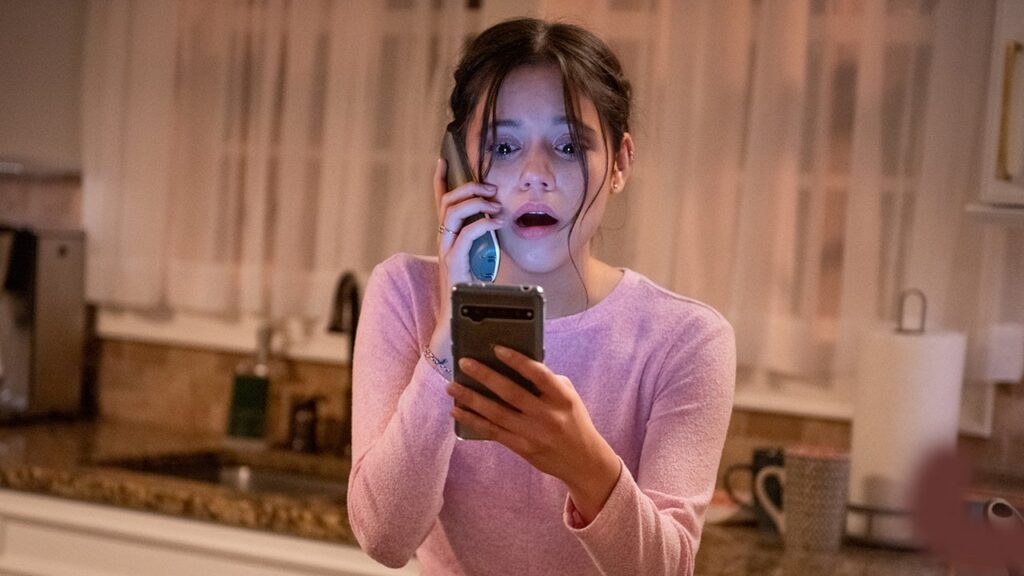
Scream 5 & 6 Is Radio Silence’s Brutal and Bloody Attitude Era
Put simply, Scream 5 and 6’s strong suit was not its characters. It was not its clever writing. The Radio Silence duology in the Scream series excelled in one thing: beating the hell out of its characters.
Wrestling fans (of which there is an unsurprising amount of crossover with horror fans) will know why I call it the Attitude Era. Just like WWE’s most infamous stretch of history, Radio Silence brought something especially aggressive to their entries. And it’s because these films were just brutal. Handing the reins to the series, Bettinelli-Olpin and Gillet gifted a special kineticism to the classic Scream chase sequences, insane finales, and especially its ruthless killers.
All five of the Ghostfaces present in 5 and 6 are the definition of nasty. They’re unrelenting, and in my humble opinion, the freakiest since the original duo of Stu Macher and Billy Loomis. Getting to hear all the air get sucked out of the room as Dewey is gutted like a fish in 5 was still an incredible moment to experience in theatres, and it’s something I don’t think would have happened if the films were any less mean and any less explosively violent.
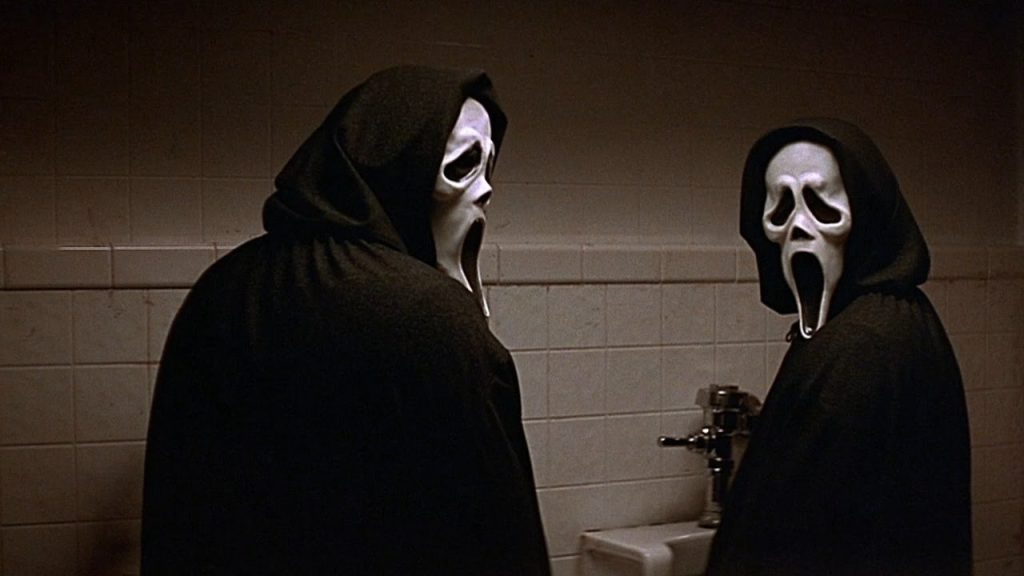
So, What Does Scream 2 Do Best Exactly?
So now, after looking at all these entries and all of their greatest qualities, what does Scream 2 have that none of the others do? What must I concede to Scream 2?
Really great character development.
Film is a medium of spectacle most of the time, and this is reflected in how we critique and compliment them. It affects how we look back on them, sometimes treating them more harshly than they deserve because they don’t have that visual flash. But for every ounce of spectacle Scream 2 lacks, I have to admit, it does an incredible job of developing Sidney Prescott as a character.
On a rare rewatch, it’s clear Neve Campbell is carrying the entirety of Scream 2 on her back just because of how compelling she makes Sidney. Watching her slowly fight against a tide of paranoia, fear, and distrust of the people around her once more, watching her be plunged back into the nightmare, is undeniably effective.
It’s also where Dewey and Gale are really cemented as a couple, and where the seeds of them always returning to each other are planted. Going from a mutual simmering disrespect to an affectionate couple to inseparable but awkward and in love is just classic; two people who complete each other in how different they are, but are inevitably pulled back and forth by those differences, their bond is one of the major highlights throughout the series.
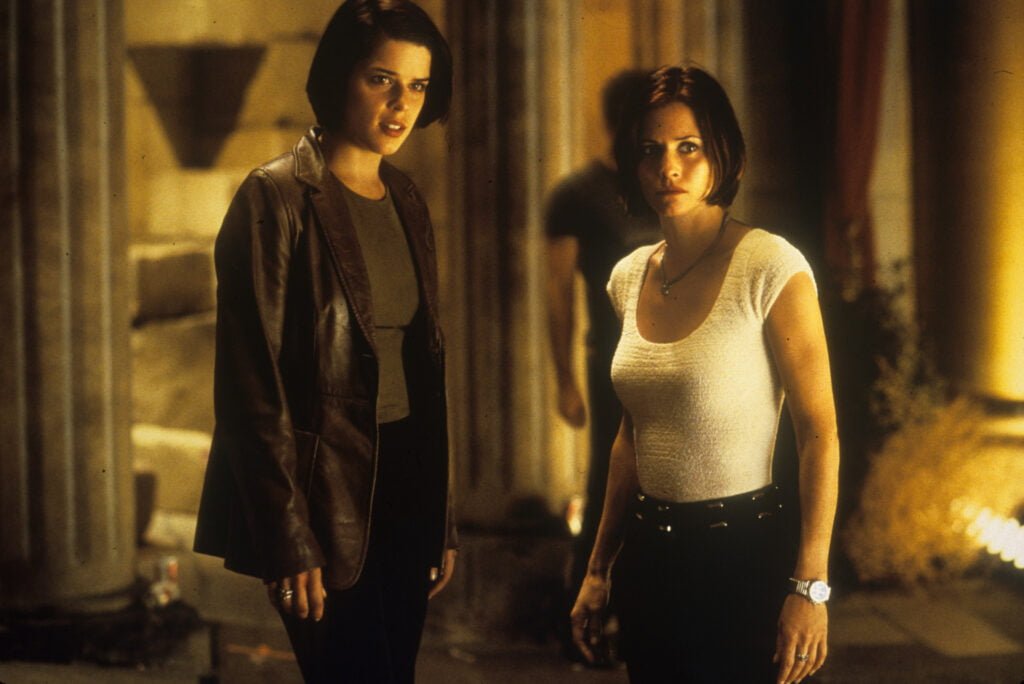
Maybe All the Scream Films Are Just Good?
These three characters are the heart of the series, long after they’ve been written out. I talk a big game about how Scream 3 is the perfect ending for the franchise, but I like to gloss over the fact that Scream 2 does a lot of the legwork when it comes to developing the characters of Dewey, Gale, and especially Sidney.
Without 2, 3 just isn’t that effective when it comes to giving Sidney her long deserved peace. Without 2, the way we see Sidney’s return in 4 & 5 doesn’t hit as hard. All of the Scream movies owe something to Scream 2 in the same way they owe something to the original Scream. I think I’ve come to a new point of view when it comes to the Scream franchise: maybe there is no bad entry. Maybe none of them have to be the worst. Each one interlinks with the others in their own unique way.
And even though I doubt I will ever really love Scream 2, it has an undeniable strength in its character writing that permeates throughout the whole franchise. And that at the very least keeps it from being the worst Scream film.
Editorials
The Halloween Franchise Peaked With H20 Here’s Why
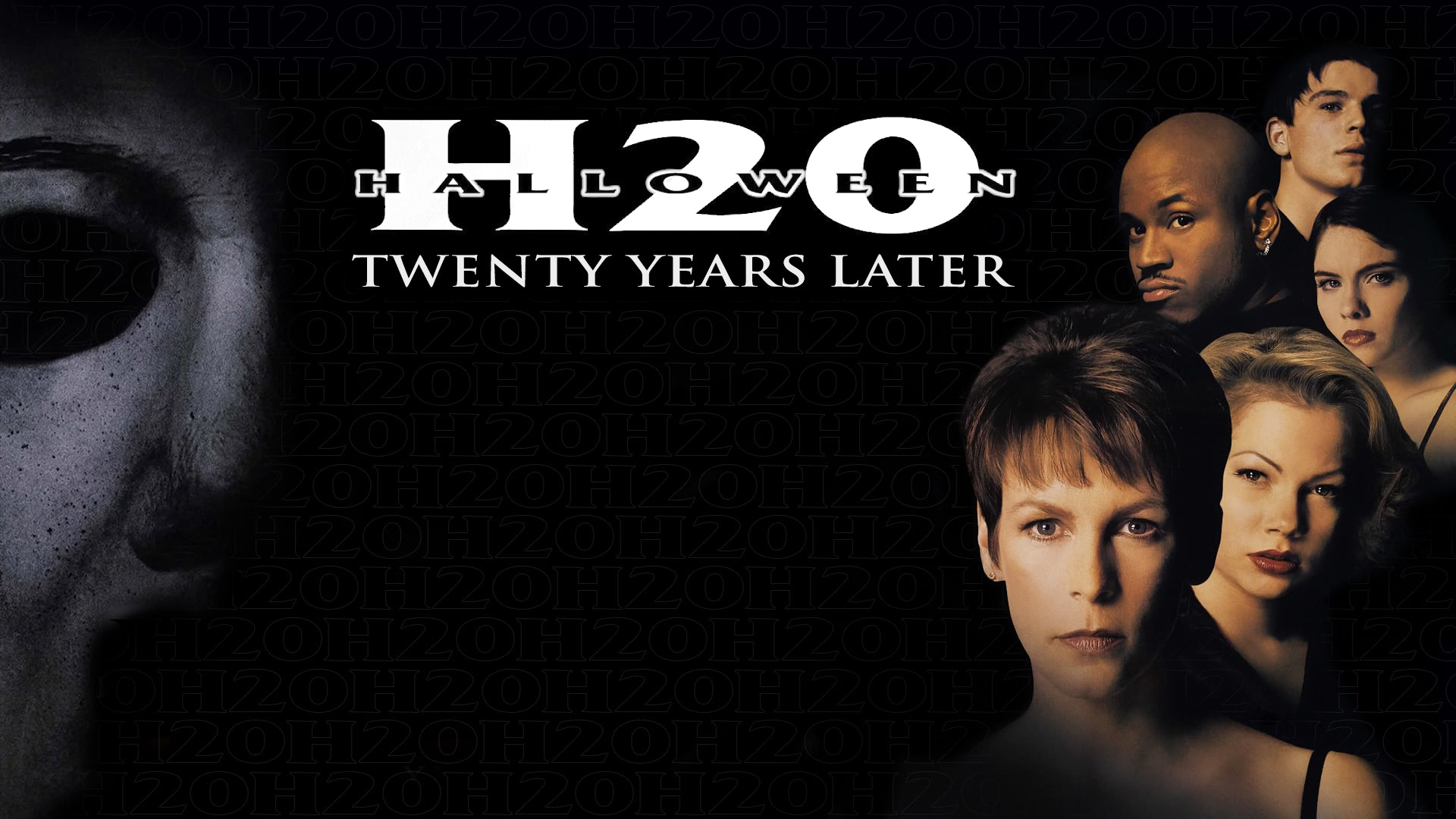
I’m going to begin this conversation with a sort of insane thought. Halloween as a franchise maybe should have ended with its first film.
That’s not to say there’s no value in the Halloween films. Much to the contrary, I like the first three films a lot. I recommend Halloween 3: Season of the Witch to people an annoying amount; I even try to watch it a few times every October to keep the vibes up. And as you already know from clicking on this article, I enjoy Halloween H20: 20 Years Later quite a bit.
I’ve even softened up on the Rob Zombie remake duology over the years. I don’t like them, but it’s like getting flowers, I can still appreciate them. However, Halloween, as a series, has long suffered from its own success. And sometimes, it feels like it’s just going to keep suffering.
HALLOWEEN’S FIRST BOLD CHOICE AFTER 16 YEARS OF WAITING
It’s easy to forget that John Carpenter’s original Halloween was effectively the Paranormal Activity of its time. Flipping a cool $70 million and change off of a $300,000 budget, it has had a genuinely immeasurable impact on the cinematic landscape and how horror films are made.
For some, that’s a bad thing. Notoriously, my beloved 3rd entry in the franchise was considered a hard misstep by audiences. Everyone knows the story; the resounding “Where’s Michael?” response to the third entry gunned down Carpenter’s desires to turn Halloween into an anthology series. So, after going into hiding for 5 years, Halloween 4 continued the story of Michael in 1988.
And then it just kept going.
As the years went on, it became progressively harder and harder to innovate, resulting in some very odd plotlines and tones. Which is why Halloween H20 is where the franchise peaked. Because it had a rare essence to it. It had guts.
It was willing to actually kill the series once and for all, even if it was impossible to do so.
EVIL DOESN’T DIE TONIGHT, THE CONTRACT SAYS SO
Before David Gordon Green’s reboot trilogy brought Laurie back as a Sarah Connor style badass, H20’s pre-production had reinvented Strode to usher in the 20th anniversary of the first film. She went from a resilient young woman into a traumatized survivor running from her past.
The original concept for Halloween H20 involved a substance abusing Laurie Strode trying to get clean so she could die with dignity against an escaped Michael. In a turn of events, she would find the will to live and kill him once and for all. It was a concept Jamie Lee Curtis was passionate about, understandably so. Laurie wasn’t the first final girl, but she was the codifier for that ideal, in a way Jess Bradford and Sally Hardesty before her weren’t. It would have made for a harrowing exploration of what was debatably the most important final girl ever.
That isn’t what happened.
There is an infamous video from a Q&A panel with Jamie Lee Curtis where she explains that the blame for Michael surviving H20 lies primarily with one man: the late great Moustapha Akkad. Akkad was famous for his business acumen, but that desire to see the Halloween franchise make bankroll had ultimately stolen away Laurie’s triumphant victory over Michael.
You see, Akkad had written a clause into the contracts surrounding the film. A clause that she could not, in no uncertain terms, kill Michael Myers. Michael would live, no matter what Laurie did. But thanks to the meddling mind of Scream creator Kevin Williamson, who had been brought on to work on the screenplay for H20, Laurie did get her vengeance in a way.
LAURIE STRODES RETURN DONE RIGHT
The actual H20 follows Laurie Strode in hiding years after Halloween 2, ignoring the events of the sequels. She’s the headmistress of a boarding school, living under a fake name far from Haddonfield with her son. But still, she can’t let go of that Halloween night. She sees Michael’s face, The Shape, everywhere. She can barely stomach talking about what happened. But when Michael kills Dr. Loomis, nurse Marion Chambers, and then finds her, Laurie is forced to face her greatest fear once and for all.
And she does. After a prolonged chase and fight on the grounds of the school, she refuses to let a wounded Michael be taken into custody. Stealing a cop’s gun and an ambulance, Laurie runs Michael off a cliff and pins him against a tree with the vehicle. She shares a brief moment with him, inscrutable eyes reflecting Michael’s. They could be expressing a number of possible emotions. Is it empathy? Hatred? Pity? Fear leaving her for the final time?
Regardless of what it is, she’s done feeling it. With a hefty swing, she decapitates him with a fire axe, ending Michael for the last time. It’s over.
Roll credits. Audience cheers. The world is healing.
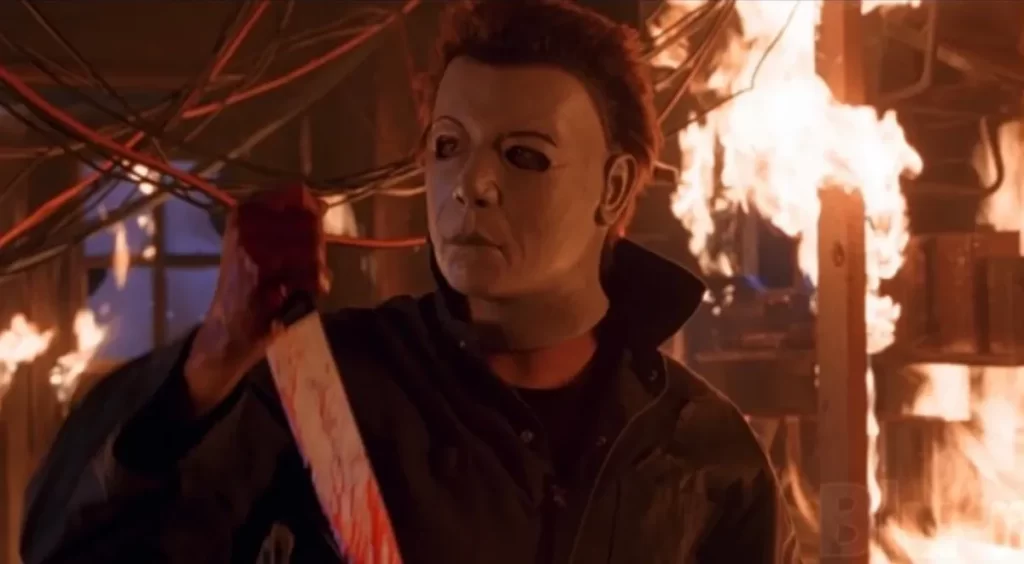
AND THEN HALLOWEEN: RESURRECTION HAPPENS
Yes, and then Halloween: Resurrection happens. Laurie is killed in the first few minutes, revealing that Michael pulled the old bamboozle switcheroonie in the previous film. She had actually just killed an ambulance driver that Michael had put the mask on. Williamson’s trick of making both Laurie and the audience believe they had killed Michael worked. But that same trick curled a finger on the monkey’s paw and led to what is definitively the worst film in the franchise.
A proto-internet streamer subplot. The kid from Smart House is there for some reason. Busta Rhymes hits Michael Myers with the Charlie Murphy front kick from that one Dave Chappelle sketch about Rick James.
Roll credits. The audience boos. Everyone who spent money on it feels like they’re being stamped to death by horses.
HALLOWEEN AS A FRANCHISE IS TERRIFIED OF ENDINGS
And this is why I say that Halloween H20 is probably the best we’re going to get out of the series, maybe ever. It is a series that, at its core, has had producers terrified of endings since even Halloween 2. Carpenter never intended there to be a sequel, or any follow ups for that matter. That was mostly the work of producer Irwin Yablans, who pushed hard to continue the story of Michael. And then, eventually, it was the work of every other producer who demanded they milk Halloween for all its worth.
H20 is a film that is antithetical to that idea. When watched as intended, ignoring Resurrection, it’s fantastic. As the end of Laurie and Michael’s story, one that shows evil is weak without fear to bolster it, it is pretty much the perfect finale. Hot off the heels of Scream’s success in 1996, H20 is often talked about as an attempt to cash in on the meta-horror craze of the 90s and early 2000s. The way people discuss it, you would think it was supposed to be a tongue-in-cheek slasher that made fun of itself and Halloween’s legacy. But in reality, aside from its humor, it ends up being quite reflective and thoughtful of that legacy.
It’s not spiteful of the films that came before it because it ends by tricking the audience. It’s what that trick represents, boldly spitting in the eye of Halloween being held prisoner for money. Mocking Halloween being stuck in an eternal cycle of rinsing and repeating the same events. It doesn’t care about franchising or longevity; it cares about telling a good story and letting its hero rest. It’s respectful to Carpenter’s creation in a way that other attempts to continue the series simply weren’t.
H20 TELLS AN ENDING, HALLOWEEN ENDS TRIES TO SELL YOU ONE
It begs the question: why does H20 work here in how it ends the series, but Halloween Ends doesn’t?
All of Ends biggest issues stem from the fact that, unlike H20, it’s trying to sell you an ending instead of making one that feels right. The maudlin closer it gives doesn’t feel real. It doesn’t feel true to the Laurie it shows us, or any other iteration of the character for that matter. It doesn’t feel genuinely emotional in any regard.
And that’s because Ends as a whole doesn’t have the spirit that H20 does. Ends is, first and foremost, a highlight reel reminding you of how cool Halloween is instead of understanding why any of its previous entries were effective. From its marketing to its incredibly clunky climax, it feels like it’s an advertisement for never letting go of Halloween, even when it should have been done a while ago. And that’s just the wrong lesson to leave on.
JANET LEIGH’S CAMEO IN H20 SPEAKS VOLUMES
Halloween H20 has a pretty famous cameo from Janet Leigh in it, an OG scream queen and the real-life mother of Jamie Lee Curtis. In it, they have a heart-to-heart as fictional characters Laurie Strode and Norma Watson. It’s made more impactful when you realize it was Leigh’s penultimate film performance, and her final performance in a horror film.
The moment serves as a cute in-joke on their real-life relationship, but more than that, it foreshadows the film’s ending. Norma urges Laurie to move past her fear, to relish her future as a survivor instead of being caught up in the past and reliving the same night over and over again.
I find this scene even more poignant now, seeing how neatly it reflects on what has happened to Halloween as a franchise in the years since the original, and especially since H20. It’s a series that got stuck in trying to continue the same story and just got progressively worse at it. In some way, it feels like it’s urging us to make a choice. No matter how deep a legacy of fear may be, it must come to an end at some point. There is no need to cling to the same stories over and over. We can enjoy them for what they are without returning to them.
No matter what the future of the Halloween franchise is, only a viewer themselves can choose where the story ends. It doesn’t matter how many times the studio brings him back, you have to make the choice. Only you decide when it ends. And for my money, H20 is the best ending you can ask for.























